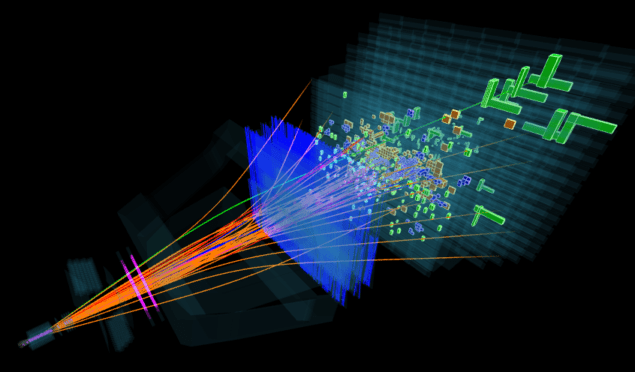
The most precise measurement of the lifetime of the Ωc0 particle has been made by physicists working on the LHCb experiment at CERN. The charmed baryon decays within femtoseconds after being produced in proton-proton collisions at the Large Hadron Collider (LHC). Surprisingly, the newly measured lifetime is about four times longer than the average of previous measurements. The researchers say that resolving the discrepancy could lead to better theoretical understanding of quark structure and interaction.
The Ωc0 consists of two strange quarks and one charm quark, and the LHCb team measured its lifetime to be 268 fs with an uncertainty of about 13%. In contrast, the average of prior measurements, taken during the late 1990’s to early 2000’s, is 69 fs with 17% uncertainty.
“Somewhat of a surprise”
The different result was “somewhat of a surprise,” says Steven Blusk of Syracuse University in the US, who led the work. It is unclear where the discrepancy comes from, or which experiments are correct. One possibility is that one of the experiments could have had an unidentified bias, points out Alexey Petrov of Wayne State University in the US, who was not involved in the work. Blusk adds, “I’d rather not speculate. It’s very hard to go back to a paper from 20 years ago and try to figure out if they did anything wrong”.
 Advertisement
Advertisement
Instead, says Petrov, this is an opportunity for theorists to refine their calculations. Current theoretical calculations, based on quantum chromodynamics models, agree with the old average lifetime, not the new measurement. However, these calculations rely on a series of potentially flawed approximations, says Petrov. Blusk adds, “This should really get people thinking about how to make the theory more precise”.
The collaboration measured the Ωc0 lifetime by studying proton-proton collisions at the LHC in 2011 and 2012. Although the particle can be produced directly in collisions, they specifically looked only for Ωc0 particles that were created by the decay of another particle called the Ωb–, which is also produced in proton-proton collisions. An important feature of the Ωb– is that it travels about 1 cm from the collision point before it decays into Ωc0, along with other particles. This means that the subsequent decay signal from the Ωc0 has relatively low noise, making it easier to analyze. The Ωc0 decay signal sought by the LHCb is the production of a proton, two negatively charged kaons, and a positively charged pion.
Limited calculations
The discrepancy in measure lifetimes highlights the limitations of current theoretical calculations, says Alexander Lenz of the University of Durham in the UK. Right now, theorists calculate lifetimes of such baryons using a technique called the heavy quark expansion, which represents the lifetime as an infinite sum. Higher order terms in the expansion describe interactions between quarks in the baryon, such as how the spin of one quark affects another quark. To actually calculate the particle’s lifetime, theorists assume higher order terms are negligible, but these assumptions are just “guesses,” explains Lenz.
In particular, Blusk says that theorists need to figure out the magnitude of a phenomenon called Pauli interference, which affects the lifetime. This is relevant in one of the first steps of the Ωc0 decay process when the charm quark becomes a strange quark along with other particles.
The next step, says Lenz, is to convince QCD theorists to actually refine these calculations. While his colleagues do find the problem interesting, they prioritize trendier topics that hint toward physics beyond the Standard Model, says Lenz. The lifetime of this baryon, on the other hand, falls squarely inside the Standard Model. And it will probably take a few years of work to more precisely calculate these higher order terms. But “it’s doable,” he says.
On the experimental side, Blusk says that the LHCb collaboration plans to re-measure the lifetime, based on Ωc0 particles directly produced in proton collisions. Although the signals from these particles will have about 40 times more noise, the measurement has different systematic biases and this could lead to a better understanding of what the actual lifetime is.
The research is described in a preprint on arXiv that has been accepted for publication in Physical Review Letters.
No comments:
Post a Comment